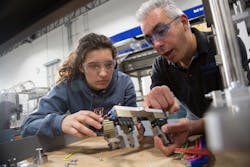A large reason for the strength of Germany’s manufacturing sector can be attributed to its well-established and highly structured apprenticeship program. This model has been brought to the U.S. through German companies with divisions or has been adopted by American businesses.
Although U.S. programs have been successful in implementing apprenticeship programs, they usually only address the needs of specific companies or industries such as manufacturing. Even with support from the U.S. Department of Labor, including an official certification process, apprenticeship opportunities remain limited.
A broader, national strategy is needed.
“Like other countries, in the U.S. we have the same strong manufacturing tradition,” says Brent Parton, deputy director of the Center on Education & Skills, at New America, a Washington, D.C.-based think tank. “But unlike those other countries, we lack a national strategy that prioritizes youth apprenticeship as an effective talent pipeline to boost the sector’s competitiveness and spread economic opportunity across the country.”
Providing economic opportunity through manufacturing historically was key to creating a middle class. Currently, that middle class is shrinking, and now policy leaders are turning their attention back to this field. Apprenticeships offer a direct route to economic prosperity according to New America.
“Apprenticeships can promote a more inclusive economy while also meeting the needs of business,” says Parton.
“How do you build equity pathways?” asks Parton. “It has to be done intentionally. You have to ensure that everyone is hearing the message about these opportunities. The message needs to be heard at an early age and then acted upon in high school. Guidance counselors need to point students in this direction. Employers need to be ready to support the success of young apprentices even if they don’t look like them or their current employees.”
And businesses have to be highly engaged, says Parton. Employers have to work with every type of academic organization. “Companies have to break out of the networks that they have always used and diversify the talent pool.”
There are many different types of future workers that can become involved in this program, which allows students to complete high school and start their postsecondary education at no cost. They can do this by working in the field while attending school. Additionally, they have the benefit of working with mentors which allows them to start along a path that broadens their options for the future.
It is for those reasons that this past October New American announced a program called the Partnership to Advance Youth Apprenticeship (PAYA). It is a multi-year, collaborative initiative that will support programs in states and cities and then expand access to high-quality apprenticeship opportunities.
This program is funded by foundations including Siemens, Joyce, Annie E. Casey and Bloomberg Philanthropies as well as companies like the Ballmer Group and JP Morgan Chase & Co. It also partners with workforce groups and programs across the country.
To ensure that the program is robust enough to become a national standard PAYA developed a set of guiding principles.
Career-Oriented --Learning is structured around knowledge, skills, and competencies that lead to careers with family-supporting wages.
Equitable --Learning is accessible to every student, with targeted supports for those adversely impacted by long-standing inequities in our education system and labor market.
Portable --Learning leads to postsecondary credentials and transferable college credit that expand options for students.
Adaptable --Learning is designed collaboratively to be recognized and valued across an industry or sector.
Accountable -Student, employer, and program outcomes are monitored using transparent metrics to support improvement.
To support states, cities, and regions working to make this vision a reality, PAYA is awarding grants to local, state, and regional partnerships from geographies both large and small, including towns and rural areas. Competitive partnerships will have leadership and support from a wide range of sectors, including K-12 and post-secondary institutions, government bodies, and local and regional businesses.
On May 29, The PAYA Grant Initiative awarded nine grants (up to approx. $200,000 each) to support partnerships of employers, education institutions, community partners, and policy leaders who are working together to build high-quality youth apprenticeship programs to meet local economic needs.
Grantees will also receive technical assistance from the PAYA National Partners and will engage as a cohort in cross-site learning activities.
Along with the Grant Initiative, the Partnership announced the PAYA Network, a national community designed to link place-based partnerships that are working to launch, expand and improve apprenticeship opportunities for high-school aged youth. With the support of PAYA, members of the Network will share best practices, co-develop solutions to shared challenges and participate in national working groups and virtual and in-person convenings.
The goal of this comprehensive program is to enable communities to become part of a “visible national community of innovators at the forefront of the movement to expand participation in high-quality youth apprenticeship programs that produce equitable outcomes for students, employers, and communities.”
Programs like these are an important step in what needs to be a continuing process to create a comprehensive apprenticeship structure which will ensure a strong U.S. economy.
